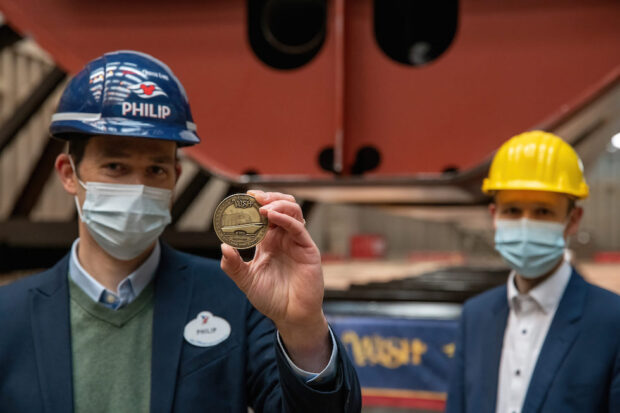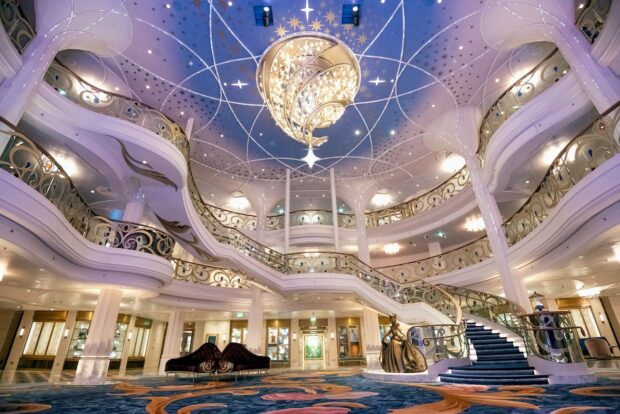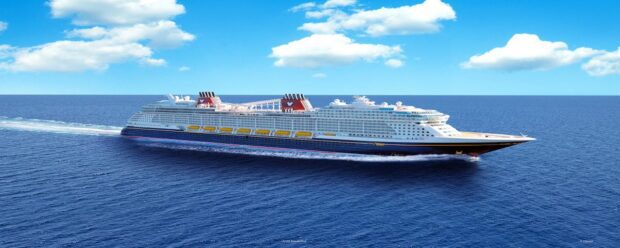Q&A: “Making the Wish: Disney’s Newest Cruise Ship” filmmakers discuss capturing Disney magic on film
For the Walt Disney Imagineering and Disney Cruise Line teams who designed and built the Disney Wish, Disney’s newest ship that debuted last year, the project was a dream come true – or more accurately, a wish come true.

The multi-year process, from the first initial sketches to the ship’s magical launch, was followed by Emmy Award-winning director, writer, and producer Chad Cohen and producer and writer Bethany Jones for the documentary “Making the Wish: Disney’s Newest Cruise Ship,” which debuted Dec. 24, 2022, on the National Geographic Channel and will begin streaming Feb. 17, 2023, on Disney Plus.
We participated in a special Q&A with Cohen and Jones to find out if making the documentary was also a wish come true.
How did you know what you wanted to film?
Cohen: We first had to frame, what is our story? Are we doing a mega engineering construction show? Are we doing design or technology? We had to figure out what we were trying to do, and we found the easiest way was to break it up. Yes, we’re building an amazing ship, a huge 144,000 gross-ton ship, so mega engineering is an easy no-brainer for National Geographic. We do those shows all the time, and that was the easiest one for us to get our heads around. But it’s not just a ship; it’s a Disney ship, so you want to see it come to life. You want to see these amazing, innovative, imaginative people take this steel and breathe life into it. So, we spoke with the Imagineers, listened to what was done and what was left to do, and figured out what we could point our camera at.

Cohen also explained that some things were obvious choices, including the installation of the bridge that’s shown towards the beginning of the film.
We found out the bridge was being installed, so it was like, ‘Whoa, we need to get the crew to Germany because the bridge going into place is one of the few things you can recognize and see the thing is taking shape,’ so we responded really quickly to that. The behind-the-scenes shoot with Anthony Mackie for the Worlds of Marvel restaurant was another thing that happened within a couple of weeks of us starting, so we didn’t really know what it was or how it was going to come together, but we knew we wanted to be there.
What was the mix of on-the-fly shooting versus actual planning?
Cohen: We definitely have plans, we definitely have a shot list, and we have scripts as much as we possibly can. We’re also very prepared to throw them all away – and it happens on pretty much every show we do. You need something to start with, but it’s more scenes than shots for us.
I knew I was going film the behind-the-scenes for the Marvel restaurant with Anthony Mackie, so even though I didn’t know exactly all the things that would happen, I knew if we showed up, we were going to get it. With construction, it’s a bigger challenge – and that’s the reason we have time-lapse cameras. Everything moves really slowly at the shipyard, so every piece you see moving is hours and hours (and it’s usually overnight because they don’t typically move them when there’s a lot of workers down below). Even with installing Rapunzel (the stern character) – which is one of my favorite scenes – there was a lot of waiting. So, it was challenging to always be prepared to pivot as necessary and cover the next great thing.

Cohen: We knew a certain amount of the show would be about construction, but we also wanted to be on the ship for a good period of time as well. We knew the float-out was happening, we knew they were going to take it out for the sea trials, and we knew they were then going to take this thing across the Atlantic. We were assured by the Imagineers that they were going to be working really hard on that crossing. I think, at that point, they thought it was going to be all the little details – and it was those – but it was also big details as well, so we filmed the crossing, and then, of course, we knew it was going to end with guests onboard.
When The Wish left Germany, it looked so “done,” so seeing how much work was needed inside was surprising. Did that work to your advantage?
Cohen: From a selfish point of view, we’re storytellers and filmmakers. Sometimes Disney has a way of making things look very easy all the time, and we were nervous about that. They’re building a giant cruise ship during a pandemic. None of this is easy. It’s an incredible challenge from a design point of view, from an innovation point of view, pushing the limits. It wasn’t easy, but for our cameras, it was looking easy, so for us, actually being there, seeing them have a challenge, and then overcoming it was amazing. We were cheering for them, and, hopefully, during the course of the film, our audience is cheering for them as well because they get to witness some of that, which is pretty rare for Disney.

Jones: There’s a scene in the film where people were working on the lights while servers are setting the tables, and all these different teams are coming into all these spaces at one time, and you could really see that it was incredible. And then we woke up in the morning and the restaurant was done. So, there were really incredible moments like that where you just saw everyone pulling together from across the company to really make the ship special, and everyone had such a sense of pride.
Sometimes, you only get one chance to get a shot (like unrolling the atrium rug). How did you prioritize what you wanted to capture?
Jones: It was such an evolving process, and we were learning in the moment. The Wish is quite large, so there might have been something happening in Worlds of Marvel, but there was also something happening in the theater – and even the teams on the ground didn’t know the exact timing. So, it was constantly being on radios or just hearing from someone that they’re putting in the screens, and you run over there and make sure you can get a camera on it. With the carpet, we found out the day before, and we knew that was going to be really special, so we had Go Pros up filming time-lapses, and we had people on the ground. Unfortunately, I can’t show all the cool footage, but the carpet vendors from England were hilarious.

Cohen: For that carpet, they knew they wanted to wait as long as they possibly could because they didn’t want the vendors working onboard to mess it up, so yes, we had time-lapses ready to go on that moment, but we were waiting a long time. It was supposed to happen at seven o’clock and then eight o’clock, and it was like midnight when that thing was finally rolling out, so a lot of it was having our ears to what the Imagineering team was doing and telling them what we wanted.
Was there anything you wanted to film, and Disney said no?
Cohen: Disney is very protective of the magic (as they should be), but National Geographic is very much behind the magic and showing it, so […] there were things early on where they said it was absolutely not going to happen, but it did happen. Like the sea trials, for example. No one has ever gone on the sea trials for any of these ships. You have a new cruise ship, you’re taking it out of the hangar essentially for the first time, and you’re kicking the tires to see what it can do. As you can imagine, there are lots of things that could go wrong. It hasn’t been tested yet. They’re these new systems, but, at the same time, everything is top-notch, and in the end, we know we’re going to have an amazing ship that’s going to sail, that’s going to be efficient, and all these great things, and so what’s the harm in showing maybe kinks along the way that they work through? That’s kind of what we were trying to do, and so they let us go out. The thing that we wanted the most was to get out on the sea trials to have this very ‘National Geographic’ test of science and speed, and they let us on. It’s a really cool aspect of the film, I think.

You show places guests don’t usually get to see (like the crew “interstate” called I-95). Can you talk about getting access to those areas?
Cohen: We worked really hard not to make this an advertisement. I know there are plenty of people at Disney that make great commercials, but it goes against what we do. There’s a legitimate story here. Passionate people and cool stuff kind of sells itself, so we didn’t have to do any of that, but we did want to show viewers things they wouldn’t normally get to see.
For us, it was really important to get to those spaces and get behind the scenes to make it feel relevant for our National Geographic audience. We had to really communicate with everyone why we wanted to do what we wanted to do, which was show how hard everyone was working to make that thing in the front of the room just so shiny, but also that there are a lot of people behind the scenes that make it happen.
Jones: I-95 is like this artery of the Wish because there’s so much traffic flowing through there of every type of [Disney Cruise Line] cast member, whether they’re an entertainment partner, or they’re a server, or they’re a cook. So, you see all these people in their different uniforms, and everybody’s rushing to get to where they need to be, and all these secret doors opening, and you peek inside – ‘oh my gosh, there’s a bakery in there, and oh my gosh, there’s a whole bunch of alcohol.’ It was such a cool space, and it was such an honor to be able to go down there. We could probably do a whole hour just on that alone.
When it was announced that The Wish had been delayed, did you consider putting that into the film?
Cohen: If we were doing a reality show, then I’d say yes, but for this, the drama of building the ship and all the innovation that goes into it [was already there]. Also, a six-week delay over the course of all these things they were doing paled in comparison to everything else, so there would have been a few people that might have cared about it, but six weeks was actually a gift of time for the Imagineers and the other people trying to get things done, so we talked about it, but we just realized it wasn’t relevant compared to the rest of the story and would have been a kind of an artificial storyline that didn’t add very much.
Even though the documentary has already been airing on the National Geographic Channel for nearly two months, Cohen said he’s looking forward to reaching a new population of viewers through Disney Plus.
Our National Geographic Channel audience was probably big into some of the engineering stuff and the big ship stuff, but we’re excited for a new audience on Disney plus who hopefully are going to be interested in some of the behind-the-scenes stuff.

